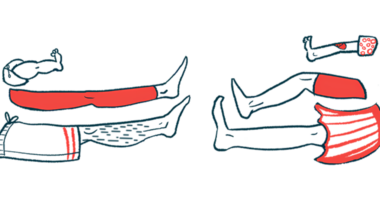AAN 2023: Oral DopaFuse reduces Parkinson’s ‘off’ time in small study
Treatment led to more stable medication levels in the blood, better symptom control

DopaFuse, a continuous oral levodopa-carbidopa delivery system, led to more stable levels of medication in the blood and better control of symptoms for people with Parkinson’s disease in a small Phase 2 study.
Warren Olanow, MD, a neurologist at Mount Sinai, presented findings from the trial at the annual meeting of the American Academy of Neurology (AAN), in the talk, “The SCOL Study: Safety, Tolerability, PK, and Efficacy Study of Continuous Oral Levodopa Administered via the DopaFuse System in PD Patients.”
The trial was sponsored by SynAgile, the developer of DopaFuse.
Parkinson’s is marked by low levels of the signaling molecule dopamine in the brain. Levodopa, which helps the brain make more dopamine, is a mainstay of treatment for the disease and is commonly given with carbidopa, which helps more of the active therapy get into the brain.
While standard oral levodopa can help control Parkinson’s motor symptoms, many patients experience “off” periods when symptoms are not fully controlled between doses. A major reason for this is because the level of medication in the body varies over time with oral therapies.
The DopaFuse system seeks to provide more consistent levels of levodopa-carbidopa. It includes a small pump attached to a clear, retainer-like device that can be worn on the teeth. The pump continually secretes small amounts of the medication into the back of the mouth, which are swallowed with the patient’s saliva. The device can be taken out for eating and brushing teeth.
Olanow said other systems have been developed with the aim of continually delivering levodopa-carbidopa subcutaneously.
“The problem is, these approaches are associated with potentially serious side effects, and they require wearing a cumbersome pump,” he said, adding DopaFuse has “no need for a [surgical] operation, no need for a big pump, or subcutaneous lesions.”
SynAgile launched a Phase 2 study (NCT04778176) to assess the safety and pharmacological properties of DopaFuse in people with Parkinson’s. The study enrolled 16 participants at sites in Europe and lasted two weeks.
Delivery system leads to stable levodopa levels, control of symptoms
For the first three days, the participants were observed in a hospital. On the first day, they took their usual oral levodopa-carbidopa therapy, but on the second day, they were given continual therapy via the DopaFuse system.
On the third day, they took one oral dose of levodopa-carbidopa in the morning then used DopaFuse the rest of the day. This same dosing order was used for the remainder of the study when patients were at home and participants went in for another assessment after two weeks.
Pharmacological data — specifically measures known as the fluctuation index and coefficient of variation — indicated levodopa levels were markedly more stable over time with DopaFuse than with standard oral medications.
“The results were striking,” showing a “highly significant reduction in variability” of medication levels, Olanow said.
This stability was accompanied by improvements in clinical outcomes. With standard oral medicines, patients had on average more than three hours of off time a day. By contrast, with DopaFuse (and oral meds in the morning), average off time a day was only about 1.5 hours.
Data also suggested patients using DopaFuse had less dyskinesia, or uncontrolled movements, a common side effect of levodopa, and significant improvements in standardized measures of their ability to function in day to day life.
The DopaFuse system was generally well tolerated, with no serious side effects reported. A few patients had mouth lesions, nausea, vomiting, or headache, though these usually resolved within a day.
“The adverse events that did occur were mild, transient, trivial, and didn’t cause anyone to drop out of the study,” said Olanow, who noted more research was needed since this was a small, short study that didn’t include a placebo group. Still, he said the early data are promising.
“If this turns out to be what we hope it is, it will allow us to deliver levodopa without motor complications, without the need for a surgical procedure, and without the risk of subcutaneous lesions or the need for an infusion pump,” Olanow said.
Note: The Parkinson’s News Today team is providing coverage of the American Academy of Neurology (AAN) 2023 Annual Meeting April 22-27. Go here to see the latest stories from the conference.







